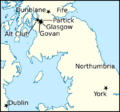Arthgal ap Dyfnwal facts for kids
Quick facts for kids Arthgal ap Dyfnwal |
|
|---|---|

Arthgal's title as it appears on folio 25v of Oxford Bodleian Library Rawlinson B 489 (the Annals of Ulster).
|
|
| King of Alt Clut | |
| Reign | ×872 |
| Predecessor | Dyfnwal ap Rhydderch |
| Successor | Rhun ab Arthgal |
| Died | 872 |
| Father | Dyfnwal ap Rhydderch |
Arthgal ap Dyfnwal (died 872) was a king who ruled the ancient British Kingdom of Alt Clut in the 800s. His kingdom was located in what is now Scotland. He came from a long line of rulers.
In 870, a major event changed his kingdom forever. Viking kings attacked and captured his main fortress, Alt Clut. Two years later, Arthgal was killed. After these events, his kingdom changed its name to the Kingdom of Strathclyde.
Contents
Who Was King Arthgal?
Arthgal was a king of the Britons, a group of people who lived in Britain. His kingdom, Alt Clut, was centered around a strong fortress. This fortress was on a large rock next to the River Clyde.
He was the son of Dyfnwal ap Rhydderch. Dyfnwal was also a King of Alt Clut. We know about Arthgal's family from old Welsh records. These records are called the Harleian genealogies.
Around 849, the Britons may have attacked a Pictish religious site. This site was called Dunblane. This attack might have happened during Arthgal's or his father's reign. It shows that the Britons were powerful. They might have been trying to expand their land. This was a time when Vikings were also attacking the Picts.
The Viking Attack on Alt Clut

In 870, two powerful Viking kings attacked Alt Clut. Their names were Amlaíb and Ímar. They surrounded the fortress for four months. This was a very long siege.
Finally, the Vikings captured the fortress. Old records say the fortress fell when its well ran dry. This meant the people inside had no fresh water. The Vikings then took many captives. These captives were Britons, Picts, and English people. They were taken to Ireland. Arthgal and his family might have been among them.
This attack was a huge event. It was even written about in faraway places. This shows how important and shocking it was.
Why Did the Vikings Attack?
Historians are not sure why the Vikings attacked Alt Clut. One idea is that it was a rich place to plunder. Another idea is that the Vikings wanted to control the area. The long siege suggests they wanted to capture the capital itself.
Perhaps the kings of Alt Clut were a threat to the Vikings' sea routes. The fortress might have been a naval base for the Britons. Destroying it would give Vikings easier access to central Scotland.
The captives included different groups of people. This might mean the Britons had many slaves. Or it could mean the Vikings attacked other areas too. They might have wanted to control more land. This attack could have been part of a bigger plan. The Vikings might have wanted to connect their lands in Dublin and York.
Arthgal's Death and the New Kingdom
Arthgal died in 872. Old records say he was killed because Causantín mac Cináeda, King of the Picts wanted him dead. Causantín was a king of the Picts.
Arthgal's son, Rhun, became king after him. Rhun was married to Causantín's sister. This family link is interesting. It might mean Causantín helped Rhun become king. Perhaps Arthgal was killed to make way for Rhun.
After the fall of Alt Clut, the kingdom's capital moved. It moved up the River Clyde to areas like Govan and Partick. The old fortress was no longer used as the main seat of power.
The Kingdom Changes Name

Because the capital moved, the kingdom's name changed too. Before, it was called Alt Clut, after the fortress. After the fortress was lost, it became known as the Kingdom of Strathclyde. This name comes from the valley of the River Clyde.
Arthgal himself is called "King of the Strathclyde Britons" when he died. This is the first time this name was used in Irish records. This suggests he might have been ruling this new kingdom. It's possible he or his son Rhun was the first king of Strathclyde.
The reasons for Arthgal's death are still a bit of a mystery. He might have been killed by the Vikings. Or, he might have been ruling as a "puppet king" for the Vikings. This means he would rule, but the Vikings would be in control. If this was true, Causantín might have killed him to gain power.
Some sources suggest there was a battle. Causantín might have defeated Arthgal in battle. Then, he might have had Arthgal killed. This would have helped Causantín become more powerful. It would also have removed a neighbor who was a threat.
See Also
- List of monarchs of Strathclyde
Images for kids





